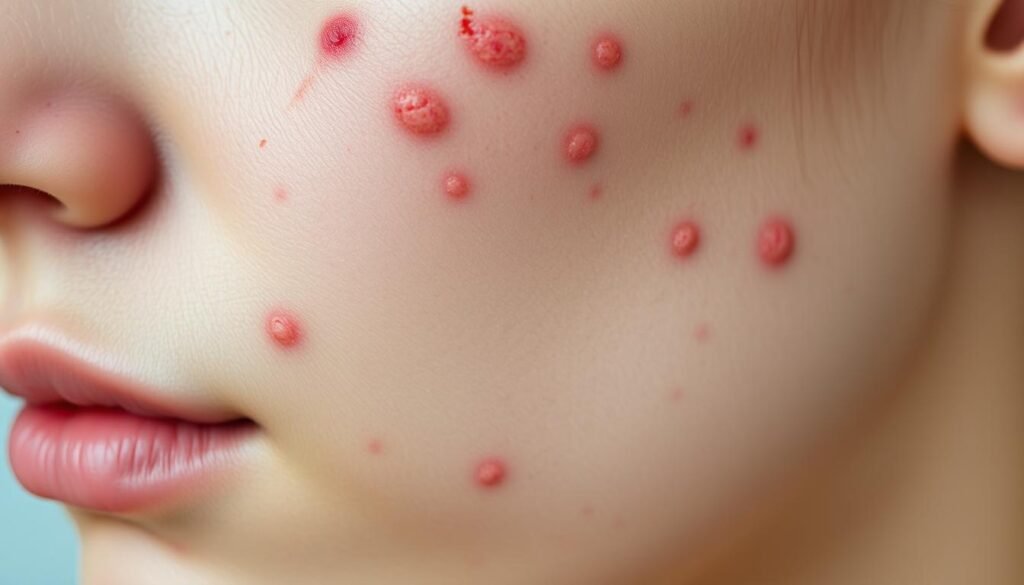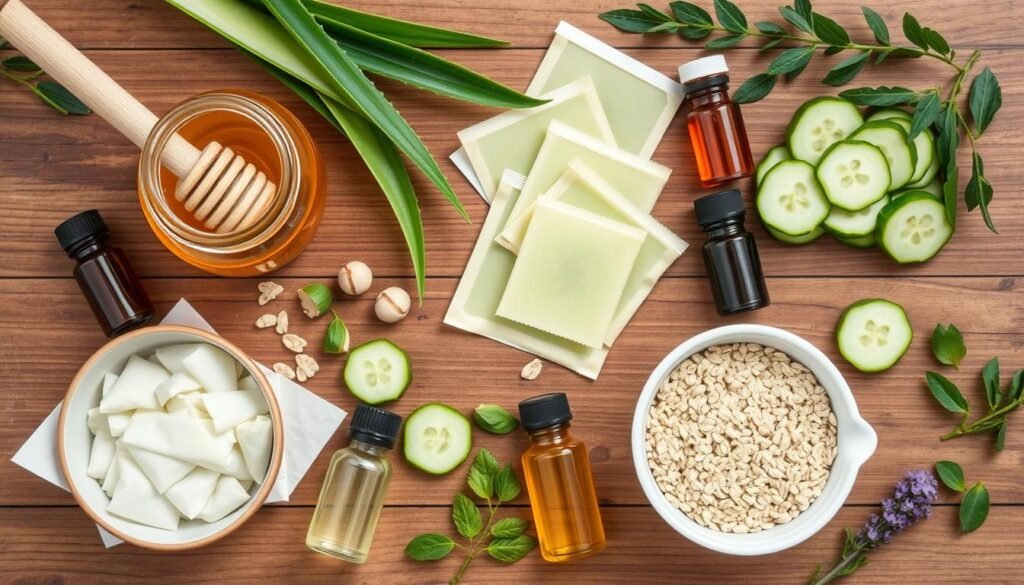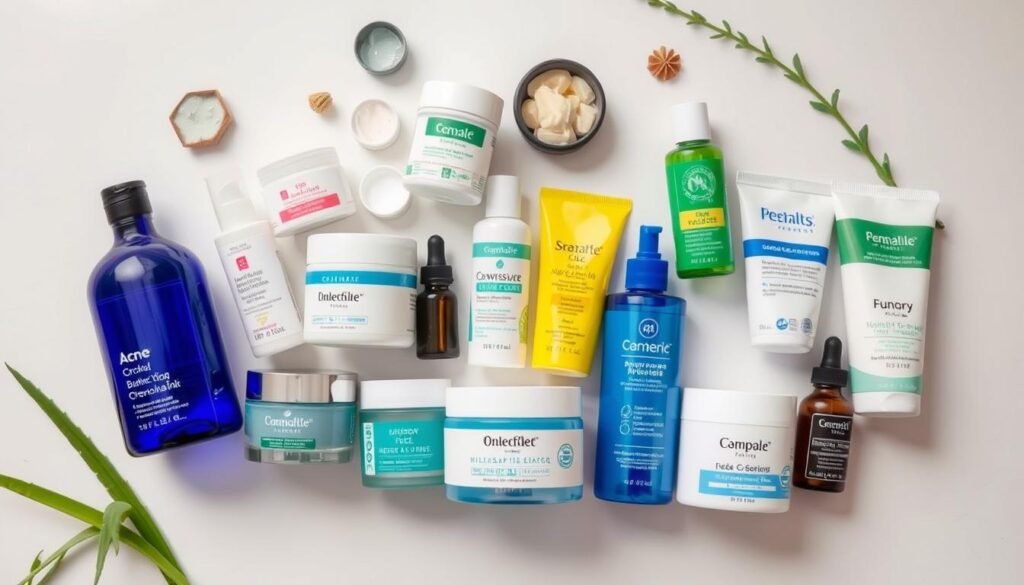Every year, around 50 million people in the United States deal with acne. Cystic acne, also known as blind pimples, causes a lot of pain and is hard to get rid of. These blemishes can stick around for weeks or even months without the right treatment. Luckily, there are many ways to fight this problem. You can try home remedies or see a dermatologist. This article is a must-read for those battling these tough spots.
Key Takeaways
- Under the skin acne affects millions, highlighting the need for effective solutions.
- Fast relief options include over-the-counter treatments like benzoyl peroxide and salicylic acid.
- Hormonal fluctuations can significantly contribute to the development of cystic acne.
- Cortisone injections can provide an impressive reduction in healing time for inflamed pimples.
- Home remedies, such as warm compresses and tea tree oil, can aid in reducing pain and inflammation.
Understanding Under the Skin Acne
Under the skin acne is painful lumps hidden beneath the surface. Known as blind pimples or cystic acne, it’s not like blackheads and whiteheads. Knowing about it can help us treat and prevent it better.
What is Under the Skin Acne?
This acne appears as inflamed spots unseen on the surface. Blocked pores full of sebum and bacteria cause them, leading to pain. Cystic acne, a severe kind, brings large, tender lumps that upset many. It’s tough to treat since it’s hidden, especially spotting blind pimples early.
Differences Between Various Types of Acne
Acne vulgaris includes many types, each differing in how serious and how they look. The main types are:
- Blind pimples: Painful, deep bumps with no head, hard to treat.
- Cystic acne: Severe, pus-filled lesions needing a doctor’s care.
- Blackheads and whiteheads: Surface spots appearing dark or white.
- Nodular acne: Hard, painful lumps under the skin.
Knowing the types helps in finding the right treatment, improving healing chances.
https://www.youtube.com/watch?v=ys_R4KZYj24
Common Causes of Under the Skin Acne
It’s important to know why under the skin acne happens for prevention and treatment. Many factors are involved. It’s key to pinpoint these for managing this skin issue.
Hormonal Fluctuations
Hormonal changes can lead to acne during puberty, periods, pregnancy, and with polycystic ovary syndrome. These changes may raise androgen levels, making more sebum. This can clog pores. Knowing these patterns helps manage and predict acne.
Clogged Pores and Excess Sebum Production
Too much sebum can cause acne. Dead skin cells and debris can clog pores. This blockage makes a breeding ground for acne, like painful cystic acne. Cleansing well reduces clogged pores and breakouts.
Role of Bacteria in Acne Formation
Bacteria, like P. acnes, are big factors in acne development. They thrive in the blocked pores filled with sebum and skin cells. When they grow, inflammation and cystic acne happen. Treating this bacteria is key in fighting acne.

How to Spot Under the Skin Acne Quickly
Spotting under the skin acne quickly helps in acting fast. These signs include painful, red bumps hidden under the skin. They are called blind pimples and can be uncomfortable.
Identifying the Signs and Symptoms
Look for these symptoms to spot acne:
- Redness around the bump
- Pain or soreness on touch
- A firm spot under the skin, showing a blind pimple
Blind pimples lack the head that whiteheads or blackheads have. Knowing these signs helps treat them right.
Differentiating Between Blind Pimples and Other Types
Blind pimples can look like other skin issues. Knowing the difference helps in choosing the correct treatment. Here’s how they compare to other pimples:
| Type of Pimple | Characteristics | Treatment |
|---|---|---|
| Blackheads | Open comedones, dark | Exfoliation and salicylic acid |
| Whiteheads | Closed comedones, white bumps | Topical retinoids |
| Papules | Red inflamed bumps | Topical antibiotics |
| Blind Pimples | Painful lumps under the skin, no head | Warm compresses and topical solutions |
For details on distinguishing acne types and treating them, see this acne guide. It boosts the success rate of managing breakouts.
Addressing blind pimples needs a unique approach. Taking preventive steps and maintaining a skincare routine helps avoid them in the future.
Effective Home Remedies for Fast Relief
Seeking fast relief from under the skin acne? Home remedies can be a great help. They are easy to use and gentle on your skin. Here are some methods to improve acne quickly.
Applying Warm Compresses
Using a warm compress can help open up pores. It promotes the appearance of a pimple’s head. This technique helps drain the pimple and reduce swelling.
Simply soak a washcloth in warm water, wring it out, and place it over the pimple for about 10-15 minutes. The gentle heat improves blood flow and soothes the pain acne causes.
Using Tea Tree Oil for Spot Treatment
Tea tree oil is known for fighting acne. A 2019 review showed that it can lessen acne sores. Mix a few drops with coconut or jojoba oil. Then, gently apply it to the pimple with a cotton swab.
This treatment can reduce swelling and clear skin over time.
Considerations for Raw Honey Application
Raw honey is a natural germ killer that helps heal skin. It’s especially good at fighting acne and preventing new breakouts. Applying a thin layer of raw honey to your skin for 15-20 minutes can soothe and moisturize it.

| Home Remedy | Benefits | Usage Method |
|---|---|---|
| Warm Compress | Opens pores and promotes drainage | Apply for 10-15 minutes on affected area |
| Tea Tree Oil | Reduces acne sores, fights bacteria | Dilute with carrier oil, apply with cotton swab |
| Raw Honey | Antibacterial properties for healing | Apply a layer for 15-20 minutes and rinse |
Over-the-Counter Treatments for Under the Skin Acne
Finding the right treatment for under-the-skin acne can greatly affect one’s confidence and skin health. Many individuals turn to over-the-counter acne treatments as effective solutions to manage their breakouts. Among these options, benzoyl peroxide, salicylic acid, and retinoids offer varying benefits, enabling people to select products based on their specific skin needs. Understanding how these active ingredients work provides the knowledge necessary for making informed decisions.
Benefits of Benzoyl Peroxide
Benzoyl peroxide is a popular over-the-counter acne treatment. It’s known for its ability to eliminate acne-causing bacteria and reduce inflammation. With concentrations ranging from 2.5% to 10%, it targets acne’s root causes and can prevent new breakouts.
Its antiseptic properties effectively soothe inflamed skin. This makes it an essential part of many acne care routines.
How Salicylic Acid Can Help
Salicylic acid is another effective option for battling under-the-skin acne. It’s known for unclogging pores and minimizing redness. This active ingredient penetrates deep into the skin, promoting exfoliation and removing dead skin cells.
It’s commonly found in concentrations ranging from 0.5% to 5%. Salicylic acid is especially liked for oily and acne-prone skin due to its gentle yet effective nature.
Understanding the Role of Retinoids
Retinoids are key in acne treatment because they speed up skin cell turnover. Adapalene, a notable retinoid available over the counter, works to prevent pore blockages. This ensures that skin looks clearer and healthier.
This ingredient not only cuts down the formation of acne. It can also better the skin’s texture and tone over time. Adding retinoids to a skincare routine provides a well-rounded approach to handling active breakouts and post-acne marks.

Choosing the right over-the-counter acne treatment requires careful thought, as everyone’s skin is different. Consistently using your selected treatment for six to eight weeks gives the best chance for success.
For more tips on effective acne management, visit this resource. It can help guide your choices.
| Ingredient | Benefits | Common Concentration |
|---|---|---|
| Benzoyl Peroxide | Eliminates bacteria, reduces inflammation | 2.5% – 10% |
| Salicylic Acid | Unclogs pores, minimizes redness | 0.5% – 5% |
| Retinoids | Accelerates cell turnover, prevents blockages | Adapalene 0.1% (available OTC) |
When to Seek Dermatology Treatments
If you’re struggling with stubborn acne, seeking professional help is a smart move. Seeing a dermatologist is key for those with ongoing or serious skin issues. They offer treatments that really get to the root of the problem.
Importance of Consulting a Professional
Professional dermatologists customize treatments in ways store-bought items can’t. They evaluate your skin carefully to figure out the best approach. This is especially true for tough cases where common remedies fail. They start with gentle treatments and only go stronger if needed, keeping you comfortable.
Possible Prescription Options
Doctors often prescribe creams like clindamycin and erythromycin to fight acne. They tackle inflammation and bacteria directly. For tougher cases, oral antibiotics or treatments that balance hormones might be needed. These strategies aim for long-term solutions, dealing with both symptoms and root causes.
Advanced Treatments for Severe Cases
For severe acne, dermatologists may suggest oral retinoids, including Accutane. They may also use cortisone shots for quick relief from painful spots. Handling acne well is crucial, not just for your skin but also for your mental well-being.
| Dermatology Treatments | Purpose | Example |
|---|---|---|
| Topical Antibiotics | Reduce inflammation and bacteria | Clindamycin, Erythromycin |
| Oral Antibiotics | Address widespread acne | Tetracycline, Minocycline |
| Hormonal Therapies | Balance hormones affecting skin | Spironolactone |
| Oral Retinoids | Severe acne treatment | Accutane |
To learn more about when to seek a dermatologist’s help, check out these online resources. The advice from a dermatologist can make a big difference on your path to clear skin.
Preventative Measures to Avoid Under the Skin Acne
Keeping your skin clear and avoiding painful acne starts with prevention. It’s important to have a good skincare routine. This should go hand in hand with managing hormones and staying clean. Together, these steps promote healthier skin and a better you.
Best Skincare Routines
For preventing acne, a regular skincare routine is key. You should wash your face twice a day to get rid of dirt, dead skin, and oil. Choose gentle cleansers over harsh ones to avoid irritating your skin. Adding products that contain salicylic acid or benzoyl peroxide can help prevent breakouts.
Managing Stress and Hormonal Levels
Stress can make acne worse, so managing it is crucial. Doing yoga, meditating, and exercising can help keep your hormones balanced. Pay extra attention to your skin during puberty or your period, adjusting your skincare routine as needed.
Keeping Your Environment Clean
Keeping your space clean is also vital in fighting acne. Wash items like pillowcases and towels often to keep bacteria and oil away from your skin. Choosing noncomedogenic makeup will help keep your pores clear.
| Preventative Step | Description |
|---|---|
| Skincare Routine | Establish a daily regimen that includes cleansing, toning, and moisturizing. |
| Stress Management | Engage in activities like yoga and meditation to reduce stress levels. |
| Hygiene | Wash pillowcases and towels regularly to minimize bacteria. |
| Product Selection | Use noncomedogenic makeup and skincare products to prevent clogged pores. |
Natural Supplements and Lifestyle Changes
Making changes in your lifestyle for better skin health is key. Using natural supplements and daily routines is important. This helps lessen the impact of acne and boosts overall health.
Benefits of a Balanced Diet
Eating well is crucial for your skin. Foods full of nutrients fight inflammation and provide essential vitamins. For people with acne, getting enough vitamins E, A, and zinc is a game-changer. Adding these vitamins to your diet can really improve how your skin looks.
Staying Hydrated for Better Skin Health
Keeping your skin healthy means staying hydrated. Drinking plenty of water eliminates toxins and enhances the skin’s look. Try to drink eight glasses of water a day. This keeps you hydrated, supports a healthy diet, and helps reduce acne.
Exercise and Its Positive Effects on Acne
Exercise is great for the skin. It boosts blood flow and lowers stress. Since stress can trigger acne by producing cortisol, working out is beneficial. It reduces stress, improves sleep, and can help clear up your skin. Adding regular exercise to your routine makes a big difference for your skin.
Conclusion
Managing under the skin acne is key for clear skin. Between 35% to over 90% of adolescents battle with it. Effective treatments help ease symptoms and avoid scars that about 20% face.
Knowing symptoms early and mixing home remedies with professional help is vital. This ensures a full approach to handle acne.
Maintaining a balanced diet, managing stress, and following a good skincare routine boost outcomes. Research highlights the role of hormones and insulin resistance in acne. Staying updated and altering treatments is important. For more on acne science, visit new acne treatments.
Personalized care is crucial for dealing with acne. A mix of lifestyle shifts and expert treatments aids in skin confidence. Clear skin is a journey needing patience and commitment.